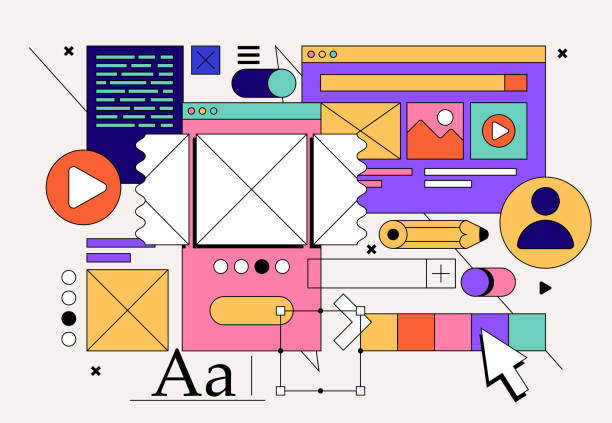Why is Secure Website Design More Important Than Ever?

In today’s digital world, where our businesses and personal lives are increasingly intertwined with the web, secure website design is no longer an option, but a vital necessity.
The ever-increasing volume of data, sensitive user information, and online financial transactions has made websites attractive targets for cyberattacks.
Every day, disturbing news of data breaches, identity theft, and disruption to online services emerges, imposing heavy financial and reputational costs on companies and organizations.
#Website_security is not just about preventing unauthorized access, but also includes protecting user privacy, ensuring data integrity, and guaranteeing continuous service availability.
An explanatory and analytical approach to this issue shows how a successful attack can not only damage a brand’s reputation but also lead to huge financial losses, legal penalties, and loss of customer trust.
This dynamic in threats doubles the importance of proactive thinking and investment in secure website design, so we can have the necessary resilience against future security challenges and provide a reliable platform for users.
This section, as a vital introduction, shows you why you should prioritize security.
Does your company’s website perform as befits your brand? In today’s competitive world, your website is your most important online tool. Rasaweb, specializing in professional corporate website design, helps you to:
✅ Gain customer credibility and trust
✅ Convert website visitors into customers
⚡ Get a free consultation!
Fundamental Principles of Web Security: Layers of Defense

Secure website design is based on a set of fundamental principles that ensure a comprehensive and layered approach to security.
These principles, which include confidentiality, integrity, and availability (CIA Triad), form the main pillars of any successful security system.
Confidentiality means protecting sensitive information from unauthorized access; ensuring that only authorized individuals can view the data.
Integrity ensures that data remains accurate and untouched over time and that no unauthorized changes have been made to it.
Availability means ensuring continuous and uninterrupted access for authorized users to the system and data, even in the face of attacks or failures.
To achieve secure website design, the ‘Defense in Depth’ approach is highly important.
This specialized approach is based on the premise that no single security layer can be 100% impenetrable.
Therefore, by implementing multiple independent and complementary defense layers, even if one layer is vulnerable, the other layers can protect the system.
These layers can include network security (firewalls, intrusion detection systems), server security (secure configuration, regular updates), application security (secure coding, input validation), database security (encryption, access control), and operational security (backup, personnel training).
Understanding these principles and implementing them in an integrated manner is the foundation of any secure and efficient web system.
Identifying and Counteracting Common Web Vulnerabilities

To ensure secure website design, recognizing and understanding common web vulnerabilities is of paramount importance.
Hackers typically exploit known weaknesses to penetrate systems.
Among the most common of these vulnerabilities are SQL Injection, Cross-Site Scripting (XSS), Cross-Site Request Forgery (CSRF), and improper Session Management.
The SQL Injection vulnerability occurs when an attacker gains control of the database by injecting malicious SQL code into input fields.
XSS allows an attacker to inject malicious code into the website and execute it in the victim’s browser, which can lead to cookie or login information theft.
CSRF is an attack that tricks a user into sending unwanted requests to a trusted website.
Specialized guidance for counteracting these threats includes rigorous Input Validation on both server and client sides, using Prepared Statements in SQL queries, proper password encryption and hashing, implementing Content Security Policies (CSP), and utilizing CSRF tokens.
Additionally, regular updates of software and libraries significantly help reduce vulnerabilities.
This practical approach is a crucial step towards secure and stable website design.
The table below lists some common vulnerabilities and methods for preventing them:
| Common Vulnerability | Brief Description | Prevention Methods |
|---|---|---|
| SQL Injection | Injecting malicious SQL code to access or alter the database. | Using Prepared Statements, input validation, least privilege database access. |
| Cross-Site Scripting (XSS) | Injecting malicious scripts into the user’s browser. | Validating and sanitizing outputs, using Content Security Policy (CSP). |
| Broken Authentication | Weaknesses in session management or login processes. | Using strong authentication, secure session management, MFA. |
| Security Misconfiguration | Incorrect configurations in server, database, or application. | Secure default configurations, removing unnecessary features, regular patching. |
The Role of SSL/TLS Security Protocols in Secure Website Design

One of the most crucial elements in secure website design and building user trust is the use of SSL/TLS (Secure Sockets Layer/Transport Layer Security) protocols.
These protocols are responsible for encrypting communications between the user’s browser and the web server, ensuring that transmitted data, such as credit card information, passwords, and personal details, remain confidential and intact during transit over the internet.
The presence of a valid SSL/TLS certificate, indicated by a green padlock in the browser’s address bar and the use of the HTTPS protocol instead of HTTP, assures users that they are in a secure environment and their connection is encrypted.
In addition to encryption, SSL/TLS also helps authenticate the server; meaning the user is assured they are communicating with the actual website server and not a fake or phishing site.
Correct implementation of SSL/TLS is crucial; mistakes such as using expired certificates, weak cryptographic configurations, or not enforcing HTTPS can jeopardize site security.
Specialized explanatory content on these protocols shows how SSL/TLS not only enhances data security but also positively impacts website SEO, as search engines like Google prefer HTTPS websites.
The choice of SSL certificate type (such as Domain Validation, Organization Validation, Extended Validation) also depends on the level of trust the website intends to provide to its users.
Ensuring proper SSL/TLS implementation is a fundamental step towards secure website design and creating a trustworthy platform for users.
Did you know that 85% of customers check your company’s website before any interaction?
With Rasaweb, build a corporate website that befits your reputation.
✅ Increase credibility and customer trust
✅ Attract high-quality leads
⚡ Get a free website design consultation
Strong Password Management and Authentication: Key to Secure Website Design

One of the most fundamental yet critical aspects of secure website design is the implementation of strong password management and authentication systems.
Weak passwords or their improper management are among the most common entry points for cyberattacks.
Educational guidelines in this area emphasize the necessity of using complex, long, and unique passwords.
Websites should encourage users to use strong passwords and implement mandatory password change policies (with an approach that doesn’t inconvenience users and ensures security).
From a developer’s perspective, storing user passwords as hashed and salted is essential, not as plain text.
Strong hashing algorithms like bcrypt or Argon2 should be used for this purpose.
In addition to passwords, implementing Multi-Factor Authentication (MFA) is highly recommended.
MFA adds another layer of security, requiring a second factor for login, in addition to the password, such as a code sent to a mobile phone, a fingerprint, or a security token.
This approach significantly reduces the risk of unauthorized access even if the password is compromised.
Furthermore, secure session management, limiting session duration, and monitoring suspicious user activities are other key aspects in this area to ensure secure website design.
CMS and Plugin Security: A Strategy for Secure Website Design

Content Management Systems (CMS) like WordPress, Joomla, and Drupal are the first choice for many websites due to their ease of use and high flexibility.
However, their open-source nature and widespread use have made these systems primary targets for cyberattacks.
Secure website design using CMS requires a specialized and meticulous approach.
The most important step in this regard is regular updates of the CMS core, plugins, and themes.
Many attacks are carried out by exploiting known vulnerabilities in older software versions, which can be fixed with a simple update.
Plugins and themes, while enhancing website functionality, can also create serious security vulnerabilities.
It is recommended to only use reputable and well-established plugins and themes from reliable sources.
Before installation, it is essential to check ratings, user reviews, and update frequency.
Additionally, deactivating and deleting unnecessary plugins and themes that are not in use can reduce the attack surface.
Practical guidelines include using a dedicated Web Application Firewall (WAF) for CMS, secure file and folder configurations (setting correct permissions), changing the default login path, using strong passwords for admin users, and employing two-factor authentication.
Continuous monitoring of logs and checking for any suspicious activity are also highly important to ensure that secure website design is maintained even after launch and remains resilient against emerging threats.
Advanced Tools and Techniques in Secure Website Design

To achieve secure website design at a professional level, the use of advanced security tools and techniques is essential.
One of the most important of these tools is the Web Application Firewall (WAF).
A WAF acts as a defensive layer between the internet and the web server, examining incoming and outgoing traffic to identify and block common attacks such as SQL Injection and XSS.
Additionally, Content Delivery Networks (CDNs), in addition to improving site loading speed, also provide extra security layers such as protection against DDoS attacks and hiding the main server’s IP address.
Analytical content in this area indicates that Penetration Testing and Vulnerability Scanning are crucial techniques for discovering weaknesses in the system before attackers find them.
In penetration testing, security experts simulate real attacks to try and breach the system and identify vulnerabilities, while vulnerability scanning automatically checks the system for known vulnerabilities.
These specialized approaches must continuously be part of the secure website design lifecycle to ensure that the system remains resilient against new threats.
| Tool/Technique | Function Description | Security Benefits |
|---|---|---|
| Web Application Firewall (WAF) | Filtering and monitoring HTTP traffic between the web application and the internet. | Protection against XSS, SQL Injection, CSRF, preventing common attacks. |
| Content Delivery Network (CDN) | A network of servers to deliver content to users based on geographical location. | Protection against DDoS, hiding the main server’s IP, increasing speed and efficiency. |
| Penetration Testing | Simulating real attacks to discover vulnerabilities. | Identifying unknown weaknesses, evaluating the effectiveness of security controls. |
| Vulnerability Scanning | Automated system scanning to find known vulnerabilities. | Rapid identification of vulnerabilities, ensuring compliance with security standards. |
Backup and Data Recovery: A Vital Strategy

Even with the best secure website design approaches, the probability of unexpected incidents, whether successful cyberattacks, human errors, or hardware failures, is not zero.
In such circumstances, having a robust backup and data recovery strategy is the most vital element for ensuring business continuity and minimizing downtime.
An explanatory guide in this area shows that precise backup planning includes three key aspects: frequency (how often backups are performed), storage location (where backups are stored), and recovery method (how information can be restored).
Backups should be performed regularly and automatically for all vital website data, including application files, databases, and any media files.
These backups should be stored in a secure location separate from the main server, preferably in cloud storage or another data center, to ensure recoverability in case of a disaster on the primary server.
The importance of secure website design is not limited to preventing attacks but also includes preparedness for worst-case scenarios.
Therefore, planning a Disaster Recovery Plan, which includes detailed steps for system recovery from backups and regular testing of this process, is essential.
This plan should be regularly reviewed and tested to ensure it functions correctly during a crisis.
Finally, training the team responsible for backup and recovery is also crucial for the success of this strategy.
Are you tired of your company’s website not meeting your expectations? With Rasaweb, design a professional website that truly represents your business.
✅ Increase acquisition of new customers and sales leads
✅ Boost your brand’s credibility and trust with your audience
⚡ Get a free website design consultation!
The Future of Web Security and New Trends in Secure Website Design

The world of web security is constantly evolving, and to maintain a secure website design, one must be familiar with new trends and emerging threats.
This section, serving as news and analytical content, takes a look at the future of web security and the challenges that web developers and administrators will face.
One of the most important of these trends is the use of Artificial Intelligence (AI) and Machine Learning (ML), both in cyberattacks and in defending against them.
Attackers use AI to automate and target phishing and social engineering attacks, while defensive systems leverage it to identify anomalous patterns and predict attacks.
This raises questionable content as to whether current tools are sufficient to counteract these threats.
Internet of Things (IoT) security is also a growing challenge, as the increasing number of internet-connected devices leads to more potential entry points for attacks.
Specialized discussions about blockchain and its potential for enhancing security (such as decentralized identity management) are also increasing.
Furthermore, the increasing use of Serverless and Microservices architectures poses new security challenges that require novel approaches to secure website design.
Awareness of these developments and preparing the necessary infrastructure to counter them is key to survival in the future security landscape.
Continuous Maintenance and Updates: Guarantor of Secure Website Design

Secure website design is not a one-time process, but an ongoing commitment.
After a website is launched, continuous maintenance and updates play a vital role in preserving its security.
This section, as an educational guide, emphasizes the importance of continuous monitoring, incident response, and regular updates.
The world of cyber threats is constantly evolving, and new vulnerabilities are discovered daily.
Therefore, all software, from server operating systems and web servers to CMS, plugins, themes, and libraries used in coding, must be regularly updated.
Setting up automatic updates where possible and reliable can help reduce risk, but monitoring these updates is essential to ensure compatibility and prevent new issues.
Monitoring logs and using Intrusion Detection Systems (IDS) to identify suspicious activities are of paramount importance.
In the event of any security incident, having an Incident Response Plan that includes identification, containment, eradication, and recovery steps can minimize damages.
Performing periodic security audits, reviewing application code, and continuously training the website development and management team on security best practices are other main pillars in ensuring secure website design and maintaining it against future threats.
This proactive approach will guarantee the stability and trustworthiness of your website.
Frequently Asked Questions
| No. | Question | Answer |
|---|---|---|
| 1 | What does secure website design mean? | Secure website design refers to a set of measures and methods employed to protect a website against cyberattacks, unauthorized access, data breaches, and other security threats. Its goal is to maintain the confidentiality, integrity, and availability of information. |
| 2 | Why is website security important? | Website security is vitally important for maintaining user trust, protecting sensitive information (such as personal and financial data), preventing financial losses, preserving brand reputation, and complying with legal regulations (like GDPR). A security breach can lead to customer loss and heavy fines. |
| 3 | What are some of the most common security attacks against websites? | Common attacks include SQL Injection, XSS (Cross-Site Scripting), CSRF (Cross-Site Request Forgery), Brute Force, DDoS attacks, Broken Authentication, and Missing Function Level Access Control. |
| 4 | What is the role of an SSL/TLS certificate in website security? | An SSL/TLS certificate (which results in an HTTPS address) is used to encrypt data exchanged between the user and the website server. This prevents eavesdropping or tampering with sensitive information such as passwords and credit card details during transmission and verifies the website’s authenticity. |
| 5 | How can SQL Injection attacks be prevented? | To prevent SQL Injection, Prepared Statements or ORM (Object-Relational Mapping) with validated parameters should be used. Additionally, thorough filtering and validation of user inputs (Input Validation) and applying the principle of least privilege in the database are essential. |
| 6 | What is HTTP Strict Transport Security (HSTS) protocol and how does it help security? | HSTS is a web security policy that instructs browsers to load the website only through an HTTPS connection, even if the user enters the address with HTTP. This prevents Downgrade attacks and cookie theft on public Wi-Fi networks. |
| 7 | What is the importance of regular software and plugin updates in website security? | Regular updates of the Content Management System (CMS), plugins, themes, and other software components of the site are crucial for patching discovered security vulnerabilities. Developers constantly release security patches, and failing to update can leave the site vulnerable to known attacks. |
| 8 | What measures can be taken to enhance the security of the website administration section (admin panel)? | Changing the default admin panel path, using strong passwords and two-factor authentication (2FA), restricting access to specific IPs, using CAPTCHA on login pages, monitoring logs, and continuous CMS updates are among these measures. |
| 9 | Why is filtering and validating user inputs (Input Validation) important? | Filtering and validating inputs helps prevent the injection of malicious code or unauthorized data through forms, URLs, or other user input sections. This prevents attacks like XSS and SQL Injection that exploit invalid inputs. |
| 10 | Name a few common tools or services for checking and enhancing website security. | Tools such as Web Application Firewall (WAF), vulnerability scanners (e.g., Acunetix, Nessus), Intrusion Detection and Prevention Systems (IDS/IPS), CDN services with security features (e.g., Cloudflare), and periodic Penetration Testing can enhance website security. |
And other services of Rasaweb Advertising Agency in the field of advertising
Smart Google Ads: A dedicated service for growth in website traffic based on real data.
Smart Marketing Automation: Designed for businesses seeking online growth through user experience customization.
Smart Marketing Automation: A professional solution for online growth focusing on custom programming.
Smart Website Development: Professional optimization for campaign management using SEO-driven content strategy.
Smart Direct Marketing: An effective tool for customer acquisition with attractive UI design.
And over a hundred other services in the field of internet advertising, advertising consultation, and organizational solutions
Internet Advertising | Advertising Strategy | Advertorial
Resources
Web Design Security TipsSecure Web ProgrammingWebsite Security on WikipediaCommon Website Vulnerabilities
? Are you ready to transform your business in the digital world? Rasaweb Afarin Digital Marketing Agency, specializing in areas such as responsive website design, professional SEO, and targeted advertising campaigns, offers innovative solutions for your sustainable growth. With us, have a powerful and memorable online presence.
📍 Tehran, Mirdamad Street, next to Bank Markazi, Southern Kazeroon Alley, Ramin Alley, No. 6



